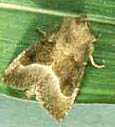Common Stalk Borer
Papaipema nebris

Figure 1. Common Stalk
Borer Adult
Description
Brown worms with white longitudinal stripes
and a distinctive purple area in the middle of the body are often found
boring into the stems of plants, particularly ragweed, oats, and corn.
The worms are active and move rapidly when disturbed. When full grown,
they are 1 1/2 to 2 inches long. The pupa is brown and spindle-shaped.
The moth has a wing expanse of slightly over one inch, and the forewings
are brown to gray with small white spots. The eggs are somewhat
globular, ridged,and laid in the creases of rolled or folded leaves,
weeds, grasses, and garden crops.

Figure 2. Common Stalk Borer Pupa
Life History
The borer passes the winter in the egg stage.
The eggs hatch in May and the worms tunnel into nearby plants, becoming
full grown in July. They then pupate, usually just below the soil
surface, and emerge as moths in August. The moths deposit eggs in August
in weeds and grassy patches, particularly along fencerows, ditch banks,
and grass waterways. There is one generation a year.
Damage
This insect tunnels into the stalks of such crops
as the small grains, grasses, and corn. The unfolding leaves of corn
plants often show irregular holes where the worms damaged them while
they were still in the whorl The heads of individual grain plants turn
white prematurely in areas in small-grain fields, especially oats.
Examination of the stalk may show this pest. Other insects that hollow
out the stems of small-grain plants can cause similar symptoms.

Figure 3.Common Stalk
Borer in Wheat Stem
Feeding occurs most frequently in rows adjacent to areas that were weedy during the previous August. Damage from this pest is usually of little economic significance.

Figure 4. Common Stalk Borer
in Corn Stalk
Scouting Procedures
Estimate the infestation by checking
20 plants in each of five locations. Check around border rows of
conventional tilled fields in May-June. In no-till fields a random check
throughout the field is necessary. Chemical control is usually not very
effective.
Threshold Guide
None established. A "rescue" insecticide
treatment may be effective if it is applied when the larvae are moving
from their weed hosts to corn seedlings. Rescue treatments applied after
the larvae have entered the plants are not effective.

Figure 5. Common Stalk Borer
Larva on Corn